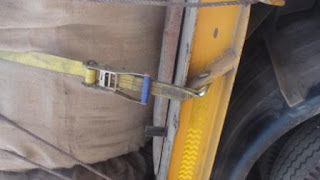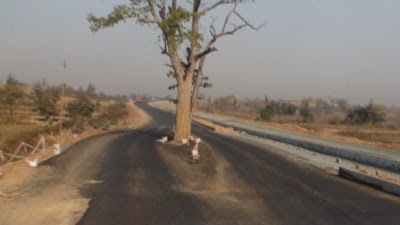
Hang on. I am not talking about the Coca-Cola TV commercial running on Indian TV sets. It sucks. That's beside the point.
The 'Brrrrr" in the title refers to myself inside the chiller room of MJ Logistics where the temperature was close to MINUS 18 degrees celsius. I repeat, MINUS 18 degrees celsius.
What was I doing inside such inhospitable terrain? Was I sentenced? Or did I volunteer? Good questions. Honestly, it was the second option.
With mercury creeping into 30 plus celsius in Delhi, the weather was getting hot. Don't know about you, but I have more than a fortnight ago folded by quilt and tucked my entire woolen gear into the mouth of my master bed to be retrieved Winter 2011 - more than 7-8 months away. Uff.
I am in the midst of trying to understand the warehouse scenario in India. As part of this exercise, have been visiting warehouses in various parts of the country. In Indian context, warehouses are nothing more than "larger" godowns is my preconceived notion. How do I correct that PCN - assuming it is wrong?
Seeing is believing is my credo or funda. So when Manisha Kumar nee Meghani of MJ Logistics invited me to visit her Palwal warehousing facility, I grabbed the chance with both hands. Seventy kilometres from Delhi and situated on National Highway 2, it was a chance to revisit beyond Badarpur which I have not done for many years.
But I did not bargain for the cold storage experience at this facility. Luminiscent yellow coated contract labour were in full swing: driving Linde forklifts and stacking food items at slots you and I cannot reach standing on floor.
Lensman Anil Baral was worked up to enter these chiller rooms. Not that he was new to this experience. Only a few weeks ago, he had visited a cold storage facility at Azadpur. Still, he was game.
Sprightly Manisha advised us to wear leather jackets to beat the biting cold if we were to enter the chiller rooms. Anil took a brown one and I grabbed a yellow one. On cue from her, one of the chiller rooms was opened for both Anil and I to enter.
 It was dark - not pitch dark. One could easily spot two more figures hovering around inside: one on a forklift and another on ground. The forklift operator was wearing a hooded mask with open slots for eyes alone! Scary, indeed.
It was dark - not pitch dark. One could easily spot two more figures hovering around inside: one on a forklift and another on ground. The forklift operator was wearing a hooded mask with open slots for eyes alone! Scary, indeed.Suddenly we began to hear crackling sound. Like the one you hear when you walk in pebbles in the paved pathways. Or on stone-strewn beachways. "What's it?" I shouted out. "Baraf (ice) on the floor," came the response from nowhere. I could not locate the voice owner.
I already started feeling numb. Maybe I would have been inside the chiller room for less than two minutes. Rubbing my eyes, I looked around and at the ceiling: height, may be, 10 metres. Was it the same height as the one I had seen at Sonepat apple processing and storage facility at Concor's subsidiary last summer? Or the ones I visited with Anil again at Rampur, 125 km from Simla belonging to Adani group? But one thing was sure, it was much larger, longer and spacious than the shark storage facility I had visited near Duqm, 400 km away from Muscat a few years ago in the company Zoher Al Araby, the Egyptian journalist who was editing an Arabic edition of economic/business magazine Alam Al iktisaad walamaal.
More about the Duqm shark storage facility, a little later.
Back to MJ Logistics' chiller room @ Palwal, 70 km away from Delhi.
 I found Anil croutching on the floor behind his tri-podded camera at the lowest level possible. I heard him giving instructions to the forklift operator to move the vehicle and "look at me" kind of instructions to get a better shot. One thing I like about photographers is that they make their targets like putty. The 'targets' are more than wiling to 'pose' for that 'snap'. Who does not like getting photographed, tell me?
I found Anil croutching on the floor behind his tri-podded camera at the lowest level possible. I heard him giving instructions to the forklift operator to move the vehicle and "look at me" kind of instructions to get a better shot. One thing I like about photographers is that they make their targets like putty. The 'targets' are more than wiling to 'pose' for that 'snap'. Who does not like getting photographed, tell me?There were corrugated boxes of foodstuff - vegetarian as well as non-vegetarian in that minus 18 degree celsius environment. Forklift was in full operation. I could vaguely see the pallette-holder moving vertically along with a lean assistant perched next to the box. Also the whirring sound of the forklift movement upwards.
Must have been inside that room for close to 5 minutes and it was getting unbearable. I exited leaving Anil behind.
'Hope Anil is okay," chirped Manisha standing outside the C.R.
When Anil came out a few seconds later, he suggested entry to other C.R.
Why?
"I want to shoot a C.R. stacked to the full," responded the son of retired Gurkha Regiment soldier and pursuing his degree through distant education.
Of course, why not?
 Manisha was game and after a brief chat with the cold storage incharge, Anil and I moved to the C.R. a few feet away. The yellow-coated assistants were ogling at Anil curiously.
Manisha was game and after a brief chat with the cold storage incharge, Anil and I moved to the C.R. a few feet away. The yellow-coated assistants were ogling at Anil curiously. "I want a shot of the entire crew around the Linde forklift," Anil said to no one in particular.
Manisha, walking alongside, gave a toothy smile. Perhaps she meant a 'Yes".
We moved into another C.R. and Anil ought to have been happy to notice the racks were stacked to the maximum.
Unforutnately, his camera got stalled.
"It's not working, Sir," he said and added a few seconds later, "maybe the chillness caused it."
What the hell?
I saw him rubbing the lenses with his palm and readjusting something in that semi-light - or is it semi-darkness?.
Leaving him behind, I came out.
Manisha was ready with a hot cuppa of tea. Very thoughtful of her.
Leaving one cup for Anil, both of us began sipping our hot beverage.
It was divine.
How does the workers manage the chillness?
They get regular rest periods during the shift. For every hour spent inside the C.R., they get one hour off, I was briefed.
They zip in and zip out constantly and that is bound to affect them, no doubt. Chances of cold-related illness is pretty high.
 Interaction with workers revealed that even on a busy day, they get to spend not more than 3 hours with breaks inside C.R. Most of the workers were in their early twenties, barring one or two elderly - above 40 age group.
Interaction with workers revealed that even on a busy day, they get to spend not more than 3 hours with breaks inside C.R. Most of the workers were in their early twenties, barring one or two elderly - above 40 age group.The entire area was spick and span. Saw safety or warning boards were being hammered into the wall.
More to come












































